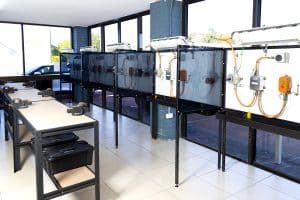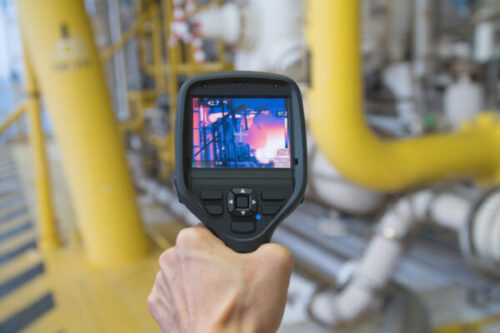The Facts About Roar Solutions Uncovered
The Facts About Roar Solutions Uncovered
Blog Article
Roar Solutions Fundamentals Explained
In order to secure setups from a prospective explosion a method of analysing and categorizing a potentially harmful area is needed. The objective of this is to ensure the proper option and installation of tools to ultimately protect against an explosion and to ensure safety and security of life.

(https://pagespeed.web.dev/analysis/https-training-roarsolution-com-au/mm9wy036rp?form_factor=mobile)
No tools ought to be mounted where the surface temperature of the devices is greater than the ignition temperature level of the offered risk. Below are some common dust hazardous and their minimum ignition temperature. Coal Dust 380C 225C Polythene 420C (melts) Methyl Cellulose 420C 320C Starch 460C 435C Flour 490C 340C Sugar 490C 460C Grain Dirt 510C 300C Phenolic Resin 530C > 450C Aluminium 590C > 450C PVC 700C > 450C Residue 810C 570C The possibility of the risk existing in a concentration high sufficient to trigger an ignition will differ from area to location.
In order to categorize this threat an installment is separated right into locations of threat relying on the quantity of time the hazardous is present. These areas are described as Zones. For gases and vapours and dirts and fibers there are three zones. Area 0 Zone 20 An unsafe ambience is very most likely to be existing and might exist for long durations of time (> 1000 hours per year) or perhaps constantly Zone 1 Zone 21 A hazardous ambience is feasible however unlikely to be existing for long durations of time (> 10 450 C [842 F] A category of T6 indicates the minimum ignition temperature level is > 85 C [185 F] Harmful area electrical tools maybe designed for use in greater ambient temperatures. This would certainly indicated on the score plate e.g. EExe II C T3 Ta + 60C( This means at 60C ambient T3 will certainly not be exceeded) T1 T1, T2, T3, T4, T5, T6 T2 T2, T3, T4, T5, T6 T3 T3, T4, T5, T6 T4 T4, T5, T6 T5 T5, T6 T6 T6 A T Class rating of T1 indicates the optimum surface area temperature generated by the tool at 40 C is 450 C. Assuming the connected T Class and Temperature level ranking for the devices are appropriate for the area, you can constantly use a tool with a much more stringent Division rating than needed for the area. There isn't a clear response to this inquiry. It actually does rely on the kind of tools and what repair work need to be performed. Devices with specific test treatments that can not be carried out in the area in order to achieve/maintain 3rd party rating. Need to come back to the manufacturing facility if it is prior to the equipment's solution. Field Fixing By Authorised Worker: Complex screening may not be required nevertheless certain procedures may require to be followed in order for the devices to preserve its 3rd event rating. Authorised employees have to be employed to carry out the job properly Repair should be a like for like replacement. New component should be thought about as a direct replacement needing no unique screening of the tools after the repair is total. Each tool with a harmful score ought to be examined separately. These are detailed at a high degree listed below, yet for even more detailed info, please refer straight to the guidelines.
The Facts About Roar Solutions Revealed
The tools register is an extensive database of tools documents that includes a minimum collection of fields to recognize each product's location, technical parameters, Ex-spouse classification, age, and ecological information. This information is essential for monitoring and managing the tools efficiently within hazardous areas. In contrast, for regular or RBI tasting examinations, the grade will certainly be a mix of In-depth and Close evaluations. The proportion of Thorough to Close assessments will be identified by the Equipment Threat, which is evaluated based on ignition danger (the possibility of a resource of ignition versus the likelihood of a combustible environment )and the hazardous location classification
( Zone 0, 1, or 2). This variant will additionally affect the resourcing requirements for job prep work. As soon as Whole lots are defined, you can establish tasting strategies based upon the example size of each Lot, which refers to the number of arbitrary tools items to be checked. To identify the needed sample dimension, 2 elements require to be examined: the size of the Lot and the group of inspection, which suggests the level of effort that need to be used( lowered, regular, or increased )to the evaluation of the Lot. By integrating the classification of evaluation with the Lot size, you can then establish the suitable rejection requirements for an example, meaning the permitted number of faulty things located within that sample. For even more information on this process, please describe the Power Institute Standards. The IEC 60079 basic recommends that the optimum period between assessments ought to not exceed 3 years. EEHA inspections will certainly likewise be carried out outside of RBI projects as component of arranged maintenance and equipment overhauls or fixings. These assessments can be credited towards the RBI example sizes within the impacted Great deals. EEHA inspections are carried have a peek at this website out to determine faults in electrical tools. A heavy racking up system is necessary, as a solitary tool may have numerous faults, each with differing levels of ignition threat. If the combined rating of both evaluations is less than twice the fault score, the Whole lot is regarded appropriate. If the Great deal is still thought about unacceptable, it must undertake a full inspection or justification, which might cause more stringent examination procedures. Accepted Great deal: The sources of any type of faults are identified. If a common failure mode is found, added tools might call for maintenance. Faults are categorized by seriousness( Security, Integrity, Housekeeping ), guaranteeing that immediate concerns are analyzed and addressed without delay to minimize any effect on security or procedures. The EEHA database must track and videotape the lifecycle of mistakes in addition to the corrective activities taken. Implementing a durable Risk-Based Assessment( RBI )approach is vital for making certain compliance and safety in taking care of Electric Tools in Hazardous Locations( EEHA) (Roar Training Solutions). Automated Mistake Scoring and Lifecycle Administration: Effortlessly take care of mistakes and track their lifecycle to improve evaluation precision. The introduction of this support for risk-based assessment further strengthens Inspectivity's placement as a best-in-class remedy for governing conformity, along with for any asset-centric inspection use instance. If you have an interest in finding out more, we invite you to request a demonstration and uncover how our solution can transform your EEHA monitoring procedures.
The 7-Minute Rule for Roar Solutions

In terms of explosive threat, a harmful area is an environment in which an explosive ambience is existing (or may be anticipated to be present) in amounts that need unique precautions for the construction, installment and use equipment. high voltage courses. In this post we discover the obstacles encountered in the workplace, the risk control procedures, and the required competencies to function securely
These substances can, in certain conditions, develop explosive atmospheres and these can have significant and heartbreaking consequences. Most of us are acquainted with the fire triangle get rid of any type of one of the 3 aspects and the fire can not happen, but what does this mean in the context of unsafe areas?
In the majority of circumstances, we can do little about the levels of oxygen in the air, but we can have significant influence on sources of ignition, for instance electric tools. Hazardous areas are recorded on the dangerous location classification drawing and are identified on-site by the triangular "EX-SPOUSE" indicator. Right here, amongst various other vital details, zones are divided right into 3 kinds relying on the danger, the chance and period that an eruptive environment will exist; Zone 0 or 20 is deemed the most hazardous and Zone 2 or 22 is regarded the least.
Report this page